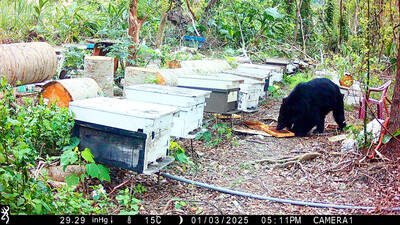Outgoing Chinese Nationalist Party (KMT) member Hsiao Shui-li (蕭淑麗) on Monday announced that she would be withdrawing from the party to run as an independent in the Chiayi City mayoral election in November, a move that could jeopardize the KMT’s chance of maintaining its control over the only pan-blue-governed administrative region south of the Jhuoshuei River (濁水溪).
The river is seen as the symbolic dividing line between those who identify themselves with the KMT and prefer closer ties with China, and those who support the Democratic Progressive Party (DPP) and other pan-green parties.
Hsiao has been a KMT member for more than three decades, during which she served as a representative of the now-defunct National Assembly before assuming leadership of the Chiayi City Farmers’ Association.
She belongs to the so-called “Hsiao family clan” (蕭家班), one of the most powerful and well-connected factions in the city.
At the press conference where she made the announcement, Hsiao cut a magnified copy of her KMT membership card in half before smashing two cardboard signs bearing the KMT and the DPP’s emblems with a baseball bat as she urged the electorate to use their votes to bring down what she called the nation’s “vicious” two-party system.
The press conference was attended by nearly 1,000 people backing Hsiao, Chiayi City Council Speaker Tsai Kuei-ssu (蔡貴絲) and Deputy Speaker Chiu Fang-chin (邱芳欽), both also of the KMT.
Hsiao said she was refusing to compete in the ruling party’s primary because of a previous “unpleasant experience.”
“I participated in the KMT’s primary for a legislator by-election in Chiayi in 2006. I beat fellow contender Chiang Yi-hsiung (江義雄) in an inter-party vote. I led Chiang by a small margin in two public polls and trailed him in only one survey, but the KMT still chose him as its candidate,” she said.
Hsiao said Chiayi voters had lost faith in the KMT because of its longstanding disregard for the city’s need for economic development, while the DPP had fueled political infighting by manipulating the public’s sentiments.
“We must not let the city become a political tool … which is why I have decided to rise above politics and be a mayor for all people,” she said.
When reached for comment, the chairman of the KMT’s Chiayi City branch, Tsai Ming-hsien (蔡明顯), said he was “shocked” by Hsiao’s decision and expressed regret over the “split in the party,” but added that he respected her move and wished her the best.
So far, three KMT members have announced their candidacy for the party’s primary for the Chiayi mayorship, including Chiayi City councilors Chang Hsiu-hua (張秀華) and Kuo Ming-pin (郭明賓), as well as former National Youth Commission minister Chen Yi-chen (陳以真), who is reportedly the preferred candidate among the KMT’s higher echelons.
With the ruling party set to conduct a public poll to choose its candidate for the Chiayi race, critics say it might lose the city to the DPP should it fail to cooperate with Hsiao in the election.

SHIPS, TRAINS AND AUTOMOBILES: The ministry has announced changes to varied transportation industries taking effect soon, with a number of effects for passengers Beginning next month, the post office is canceling signature upon delivery and written inquiry services for international registered small packets in accordance with the new policy of the Universal Postal Union, the Ministry of Transportation and Communications said yesterday. The new policy does not apply to packets that are to be delivered to China, the ministry said. Senders of international registered small packets would receive a NT$10 rebate on postage if the packets are sent from Jan. 1 to March 31, it added. The ministry said that three other policies are also scheduled to take effect next month. International cruise ship operators

NUMBERS IMBALANCE: More than 4 million Taiwanese have visited China this year, while only about half a million Chinese have visited here Beijing has yet to respond to Taiwan’s requests for negotiation over matters related to the recovery of cross-strait tourism, the Tourism Administration said yesterday. Taiwan’s tourism authority issued the statement after Chinese-language daily the China Times reported yesterday that the government’s policy of banning group tours to China does not stop Taiwanese from visiting the country. As of October, more than 4.2 million had traveled to China this year, exceeding last year. Beijing estimated the number of Taiwanese tourists in China could reach 4.5 million this year. By contrast, only 500,000 Chinese tourists are expected in Taiwan, the report said. The report

The Forestry and Nature Conservation Agency yesterday launched a gift box to market honey “certified by a Formosan black bear” in appreciation of a beekeeper’s amicable interaction with a honey-thieving bear. Beekeeper Chih Ming-chen (池明鎮) in January inspected his bee farm in Hualien County’s Jhuosi Township (卓溪) and found that more than 20 beehives had been destroyed and many hives were eaten, with bear droppings and paw prints near the destroyed hives, the agency said. Chih returned to the farm to move the remaining beehives away that evening when he encountered a Formosan black bear only 20m away, the agency said. The bear

Chinese embassy staffers attempted to interrupt an award ceremony of an international tea competition in France when the organizer introduced Taiwan and displayed the Republic of China flag, a Taiwanese tea farmer said in an interview published today. Hsieh Chung-lin (謝忠霖), chief executive of Juxin Tea Factory from Taichung's Lishan (梨山) area, on Dec. 2 attended the Teas of the World International Contest held at the Peruvian embassy in Paris. Hsieh was awarded a special prize for his Huagang Snow Source Tea by the nonprofit Agency for the Valorization of Agricultural Products (AVPA). During the ceremony, two Chinese embassy staffers in attendance